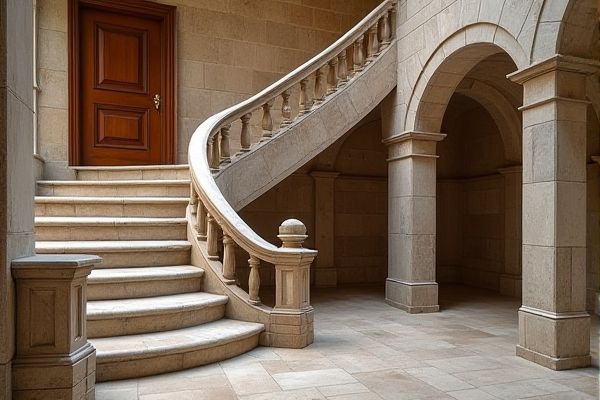
Stone staircases offer exceptional durability and a timeless aesthetic that enhances outdoor and indoor spaces, while wood staircases provide warmth and versatility, easily customizable to fit various interior styles. Discover the pros and cons of each option to determine which staircase best suits Your home's design and functionality by reading the full article.
Table of Comparison
| Feature | Stone Staircase | Wood Staircase |
|---|---|---|
| Durability | Highly durable, resistant to wear and weather | Moderately durable, prone to scratches and dents |
| Maintenance | Low maintenance, easy to clean | Requires regular polishing and treatment |
| Cost | Higher initial cost due to materials and installation | Generally more affordable |
| Aesthetic Appeal | Elegant, classic, natural stone look | Warm, versatile, wide range of finishes |
| Installation Time | Longer installation period | Quicker and easier to install |
| Safety | Can be slippery, requires anti-slip treatment | Better grip, safer underfoot |
| Environmental Impact | High energy consumption, non-renewable material | Renewable, eco-friendly if sourced sustainably |
Introduction to Stone vs Wood Staircases
Stone staircases offer unmatched durability and a timeless aesthetic that enhances architectural elegance, while wood staircases provide warmth and versatility with numerous design options. Your choice depends on factors like maintenance preferences, budget, and the overall style of your space. Stone requires less upkeep and resists wear, whereas wood allows for customization and a cozier atmosphere.
Durability Comparison: Stone and Wood
Stone staircases offer exceptional durability, resisting wear, weather, and heavy foot traffic for decades with minimal maintenance. Wood staircases, while aesthetically warm and versatile, are more prone to scratches, dents, and moisture damage, requiring regular upkeep to maintain structural integrity. You should consider stone for long-lasting strength and wood if you prefer a natural look but are prepared for periodic care.
Aesthetic Appeal and Design Versatility
Stone staircases offer a timeless, natural beauty with rich textures and colors that enhance architectural elegance, making them ideal for rustic, classic, or modern designs. Wood staircases provide superior design versatility, allowing for varied finishes, styles, and intricate detailing that suit both traditional and contemporary interiors. The choice between stone and wood significantly impacts the home's aesthetic, with stone emphasizing durability and permanence, while wood offers warmth and adaptability to diverse design themes.
Installation Process and Complexity
Stone staircases require a more labor-intensive installation process due to the heavy materials and precise measurements needed for cutting and fitting, often involving skilled masons and longer project timelines. Wood staircases offer greater flexibility with simpler tools and techniques, allowing for faster installation and easier adjustments on-site, making them more suitable for DIY projects or renovations. Your choice between stone and wood will impact not only the complexity but also the cost and duration of the installation process.
Cost Analysis: Initial and Long-Term
Stone staircases demand a higher initial investment due to material and labor costs but offer exceptional durability and low maintenance, making them cost-effective in the long term. Wood staircases present a more affordable upfront cost yet require regular upkeep, refinishing, and potential repairs that can accumulate expenses over time. Your choice should balance budget constraints with expected lifespan and maintenance commitments to optimize overall cost efficiency.
Maintenance Requirements and Longevity
Stone staircases require minimal maintenance due to their natural durability and resistance to weather, pests, and wear, ensuring a lifespan that can exceed several decades with little upkeep. Wood staircases demand regular care, including sealing, staining, or painting to protect against moisture, rot, and insect damage, typically lasting 20 to 30 years with proper maintenance. Choosing between stone and wood staircases depends on balancing long-term durability with the willingness to perform periodic maintenance to preserve appearance and integrity.
Safety and Slip Resistance
Stone staircases offer superior durability and natural slip resistance due to their textured surfaces, making them less prone to wear and smoother with age. Wood staircases, while aesthetically warm, often require additional treatments like anti-slip coatings or textured treads to enhance safety and reduce the risk of slipping. Proper maintenance plays a critical role in maintaining slip resistance for both materials, with stone typically demanding less frequent intervention compared to wood.
Environmental Impact and Sustainability
Stone staircases have a lower environmental impact due to their durability and natural materials that require less frequent replacement, reducing resource consumption. Wood staircases, while renewable and biodegradable, often involve deforestation and chemical treatments that can harm ecosystems unless sourced from certified sustainable forests. Choosing Your staircase material influences long-term sustainability by balancing resource use, carbon footprint, and lifecycle environmental effects.
Resale Value and Home Appeal
Stone staircases significantly enhance your home's resale value by offering durability, timeless elegance, and low maintenance, which appeal to buyers seeking long-lasting quality. Wood staircases provide warmth and versatility with various styles and finishes, attracting buyers who prefer a classic, cozy aesthetic. Choosing between stone and wood affects your home's overall appeal and marketability, with stone often commanding higher offers and wood offering greater design flexibility.
Choosing the Right Material for Your Staircase
Stone staircases offer unparalleled durability and a timeless aesthetic that enhances both indoor and outdoor spaces, while wood staircases provide warmth, versatility, and easier customization for various interior styles. Consider factors like maintenance requirements, design preferences, and budget when choosing the right material for your staircase. Your decision should balance the longevity and sturdiness of stone with the natural beauty and adaptability of wood to best suit your home's needs.
 homyna.com
homyna.com